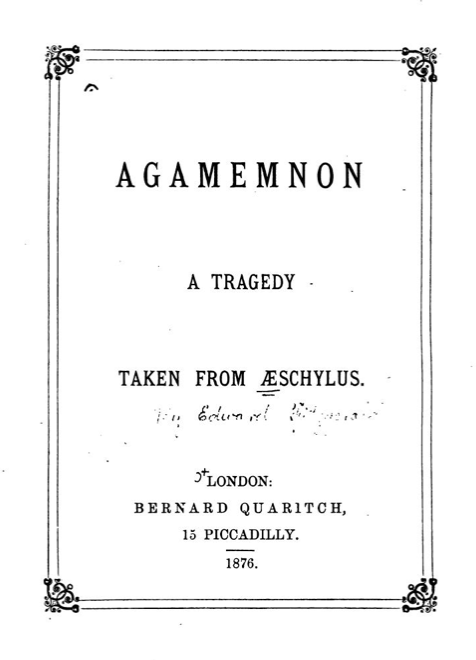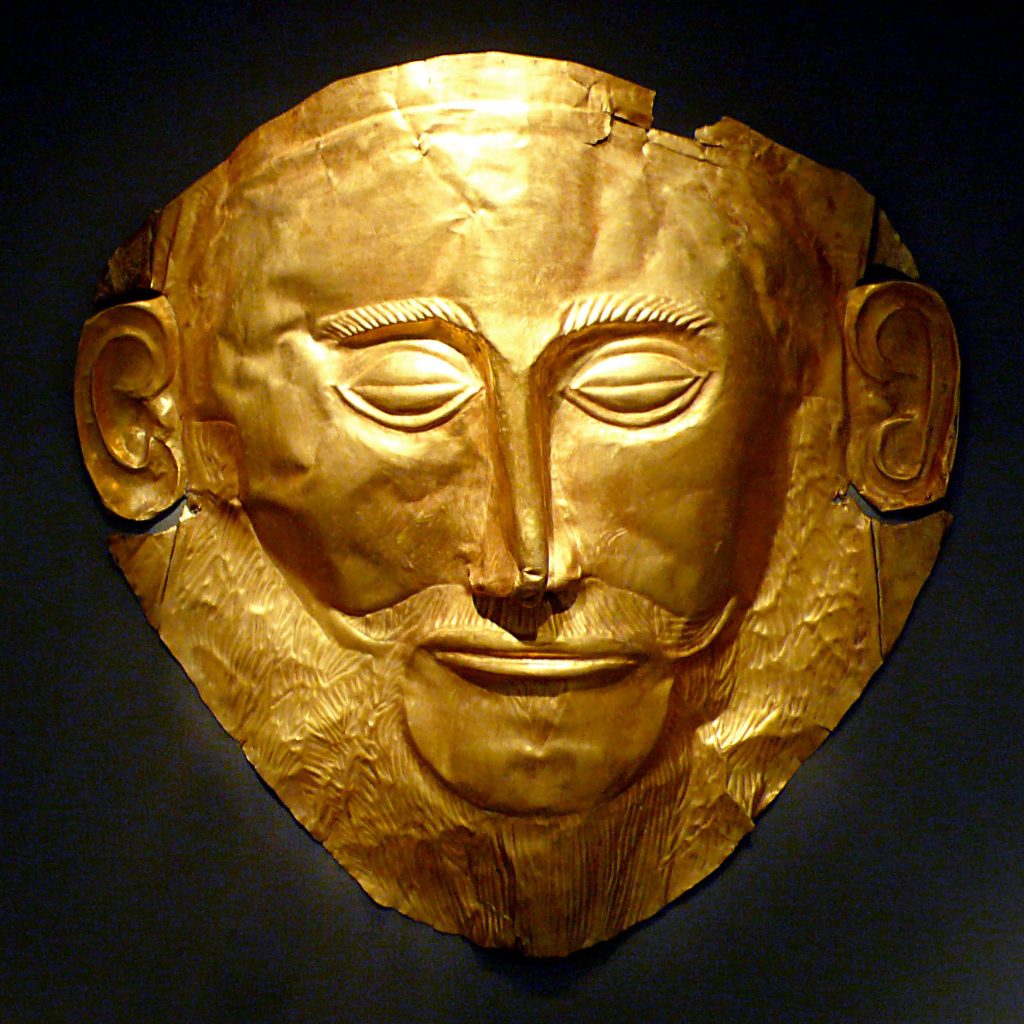
As befits a well-educated nineteenth century writer, the library of John Addington Symonds was extensive both in volume number and in subject matter. Of course, cataloguing the contents of his library—recreating it at least digitally, and assembling as many physical components of its contents as possible—provides insight into Symonds’ interests and allows us to trace the sources of ideas furthered by his own writing.
Yet choosing to believe that every volume contained in Symonds’ library correlates directly to his publications-thus assuming that he acquired books with the intent of creating a cohesive research library-is impractical. Some books were doubtlessly purchased as souvenirs, others were passed down to Symonds by his father or were copies he may have picked up in school, and a few were presented to him as gifts from their respective authors or publishers.
One of these is a translation of Aeschylus’ Tragedy of Agamemnon, which contains the inscription “With the Publisher’s Compliments.” Published by Bernard Quaritch in London during the year 1876, the title page reads “Agamemnon A Tragedy taken from Aeschylus.” (1) Symonds’ copy contains a scrawling handwritten signature crediting the book to Edward Fitzgerald. Whether it was the translator himself who signed the book or merely the publisher’s effort to clarify the source of the material, it is worth noting that a copy from the same edition available online contains the same inscription, though the hand is different. Symonds’ copy is clearly expensive, a collectible: the text on each of its pages is framed by ornate detailing, and the format of the book is clearly meant to be beautiful rather than utilitarian.

The preface—presumably also written by Fitzgerald, though it is unsigned—is amusingly apologetic for the “per-version” of Aeschylus’ original text that this translation constitutes. (2) As the first volume in the Oresteia, widely considered to be Aeschylus’ most famous work, the Tragedy of Agamemnon chronicles the death of its titular character King Agamemnon of Argos, who is betrayed by his queen Clytemnestra. Although it is likely that Symonds was also familiar with the other pieces in the Oresteia, which countinue the tale of the house of Atreus with Aeschylus’ “Choephori” (or “The Libation Bearers”) and “The Eumenides,”this particular translation is only the first book.
As a classicist, it is not odd for Symonds to have possessed Fitzgerald’s Agamemnon. Aeschylus’ name appears in Symonds’ memoirs a few times, as well as in some of his letters. Agamemnon is referenced specifically in a postscript found in a letter to Mrs. Blanche Arthur Hugh Clough: the reference reads, “Soul-wounding flower of love is in AEschylus.” A footnote in the Letters explains this relatively cryptic sentence, providing a quote from Arthur Way’s translation of Agamemnon: (3)
An arrow of desire
That archer-eyes were winging
A flower soul-thrilling, springing
Out of love’s bed of fire. (4)
Another reference, this time to the Oresteia as a whole rather than Agamemnon, appears in one of Symonds’ first letters, written during his time at Harrow to Charlotte Symonds. Once again in a footnote, Symonds writes,
Would you look and see whether in Schlegel’s Dramatists there is any thing on the characters of Clytaemnestra & Lady [Blank] or about the plays of Macbeth & Aeschylus’ Orestea. I am going to take Aeschylus’ idea of Clytam (5)
The rest of the letter is incomplete, and Symonds’ decision to take up an idea belonging to Aeschylus remains unexplained. However, it is interesting to note that this letter, written in 1858, predates the Fitzgerald Agamemnon. Clearly, Symonds knew the story of the first volume of the Oresteia long before a copy of Fitzgerald’s translation came into his possession: perhaps it is even possible to guess that the earlier copy of the Way translation he cites in the first letter provided his first reading of the Agamemnon.
Apart from taking place in Greece, the material found in Fitzgerald’s translation of Agamemnon is not closely connected to Symonds’ more famous works. Instead, the play’s presence in Symonds’ library provides an insight into the complex and interconnected world of authors, publishers and scholars during the nineteenth century, and remind us that Symonds read widely and was interested in more than the subjects for which he is remembered.
Footnotes:
(1) Aeschylus. Agamemnon.
(2) Aeschylus. Agamemnon.
(3) Letters II:365.
(4) Aeschylus, Agamemnon (Way).
(5) Letters I:134.
Works Cited:
Aeschylus. Agamemnon, a Tragedy. Translated by Edward FitzGerald. London: Bernard Quaritch, 1876. https://archive.org/details/agamemnonatrage00fitzgoog/page/n3.
Aeschylus. Aeschylus in English Verse. Translated by Arthur S. Way. London: Macmillan, 1908.
Symonds, John Addington. 1923. Letters and Papers of John Addington Symonds. Edited by Horatio F. Brown. New York: C. Scribner’s Sons.
Symonds, John Addington. 2016. The Memoirs of John Addington Symonds: a Critical Edition. Edited by Amber K. Regis. London: Palgrave Macmillan.

